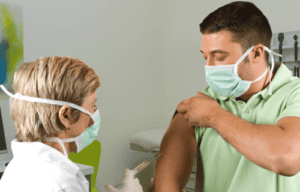
Providing routine patient care under COVID-19 restrictions has been a delicate balance. While following physical distancing and infection control safeguards, you also have to protect your bottom line. These three strategies will help your practice more successfully offer Medicare annual wellness visits (AWV) and preventive services in new ways to restore your finances and provide much-needed care.
1. Restoring Vaccination Rates Is Critical
Since the start of the pandemic, the administration of childhood vaccinations have dropped: by 50 percent for measles, mumps and rubella shots; by 42 percent for diphtheria and whooping cough shots; and by 73 percent for HPV vaccines, reports the New York Times. If immunizations rates drop, the concern is that the United States could face an increase in the communicable diseases that healthcare workers have worked so hard to eradicate.
Bottom line: Some “in person” visits do need to happen—children need vaccinations, pregnant women need fetal and maternal health monitoring, and patients with new or worrisome health concerns need care to diagnose and treat conditions that could become worse if left unattended.
2. Reconfigure Scheduling of Preventive Appointments
Although many states required you to postponed elective procedures to slow the spread of COVID-19, this didn’t mean all routine visits should cease. “Ensuring the delivery of newborn and well-child care, including childhood immunization, requires different strategies,” notes the Centers for Disease Control and Prevention (CDC).
Although it will be a while before things get back to “normal,” there are safe ways you can reduce the risk of infection and continue providing routine patient visits during COVID-19:
- Stagger your visits. When scheduling appointments, the CDC recommends scheduling your routine patient visits for the first half of the day and sick visits for after lunch. This scheduling strategy will allow you to disinfect your practice in between well and sick visits, and reduce well patients from being exposed.
- Segregate by location. If your practice has more than one office, you could designate one location for routine and well child visits, and a separate location for patients who are sick, suggests the CDC. While it may be a little inconvenient for patients to travel to a different location than they’re accustomed, it’s a way for you to provide a safer environment for well visits. You could also collaborate with providers in the community to identify separate locations for holding well visits for children, notes the CDC.
- Consider curbside visits. Get creative with how you approach patient care. Immunizations, blood pressure checks, ear checks, and a number of other routine visit care can be administered via a “curb-side” service. Whether you set up a tent, remodel your parking lot, or literally have patients drive up to the curb, keeping patients outside gives them peace of mind as it limits exposure to germs.
3. Leverage Expanded Telemedicine Offerings
Using telemedicine instead of face-to-face encounters for routine medical visits is a strategy used to slow the spread of COVID-19, notes the CDC. Offering telemedicine visits allows patients to keep their routine visits without exposing themselves or your practice and staff. Relaxed payer policies make it possible for you to provide covered preventive telehealth exams and get paid for the services. The new rules include:
- CMS’ April 30th rules expanded telehealth to Annual Wellness Visits (AWV) (G0438, G0439)
- The American Academy of Pediatrics released childhood preventive medicine telehealth guidelines (99381-99397).
You should inquire with each of your payers about their individual telemedicine policies so you or your patients don’t get left footing the bill. Here are some key points you should investigate:
- Coverage Expiration Date: What are the effective dates for telemedicine coverage? Most insurers are limiting this exemption to a specific period of time.
- Covered Codes: What services will they reimburse for, and where do the services have to take place?
- Eligible Staff: May these services be provided by Nurse Practitioners, Physician Assistants, and other Qualified Healthcare Providers (QHP)?
- Billing Requirements: How do you need to bill for those services—should you use telehealth codes or office visit codes, and what modifiers are necessary?
- Diagnosis Limitations: Is telemedicine reimbursed only for services related to COVID-19?
To boost your reimbursement, you must apply the accurate coding and billing these services require. Down the road, auditors will be looking for key items to support the codes, so to avoid future penalties, it’s critical that your claims withstand scrutiny.
This is where nationally-recognized coding and training expert, Kim Garner Huey, MJ, CHC, CPC, CCS-P, PCS, CPCO, COC, can help. During her upcoming online training session “Proven Annual Wellness, Preventive Medicine Billing for Every Setting,” Kim will provide step-by-step guidance on how you can get paid for annual wellness and preventive medicine services to prevent costly penalties in the future.



